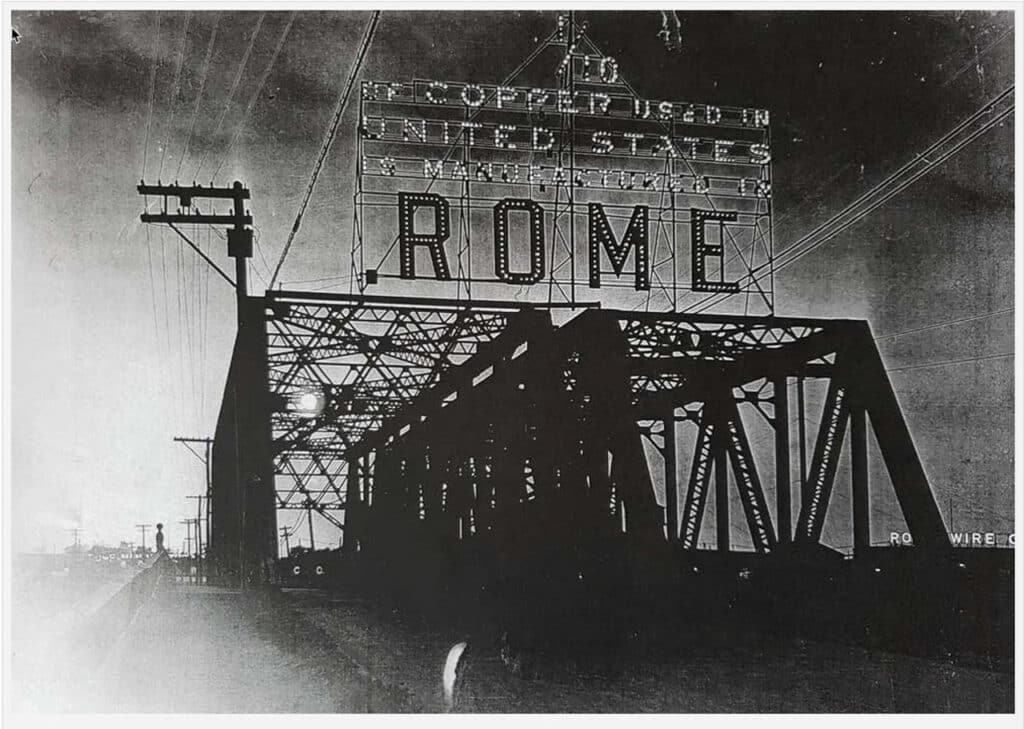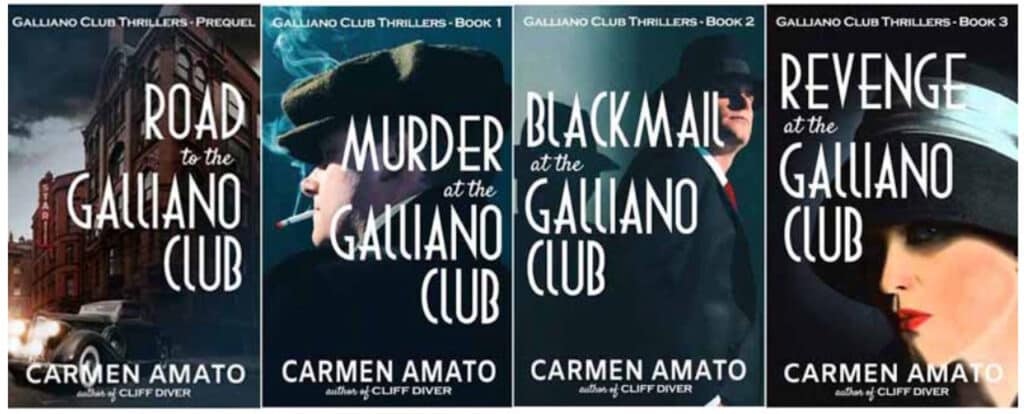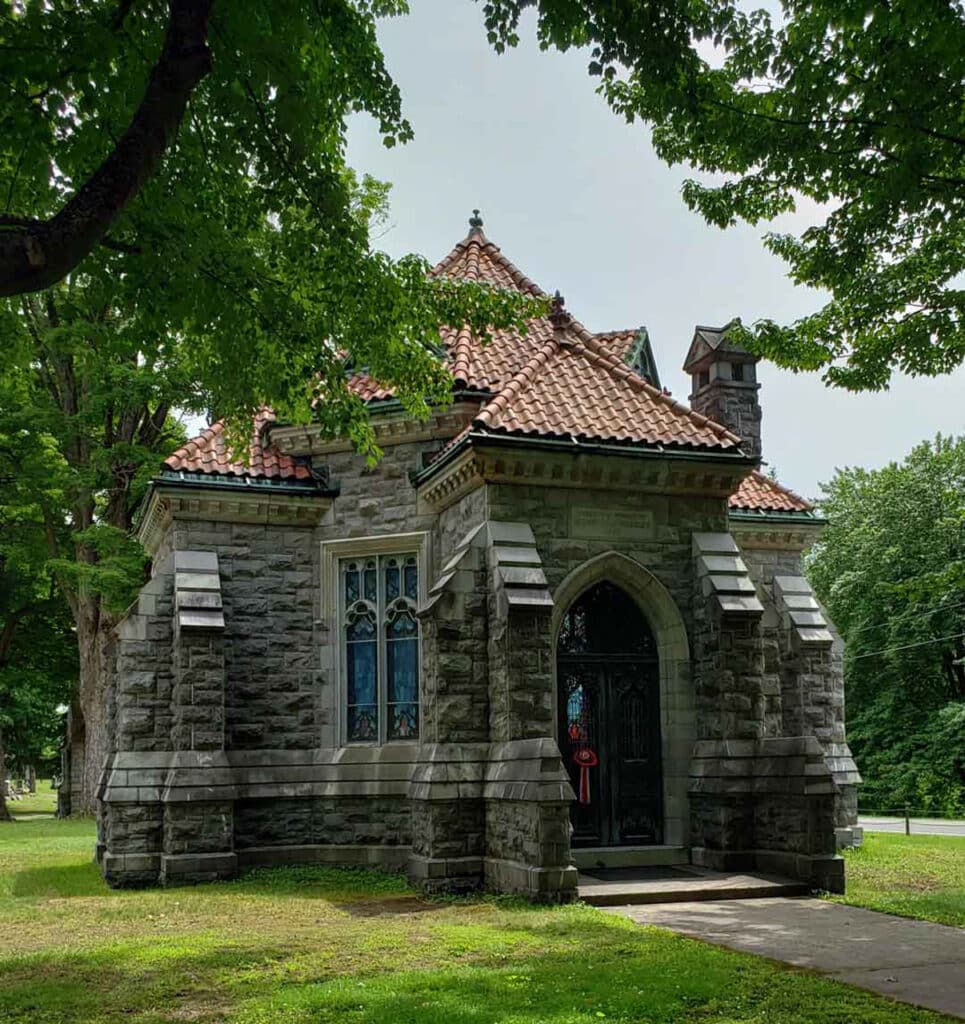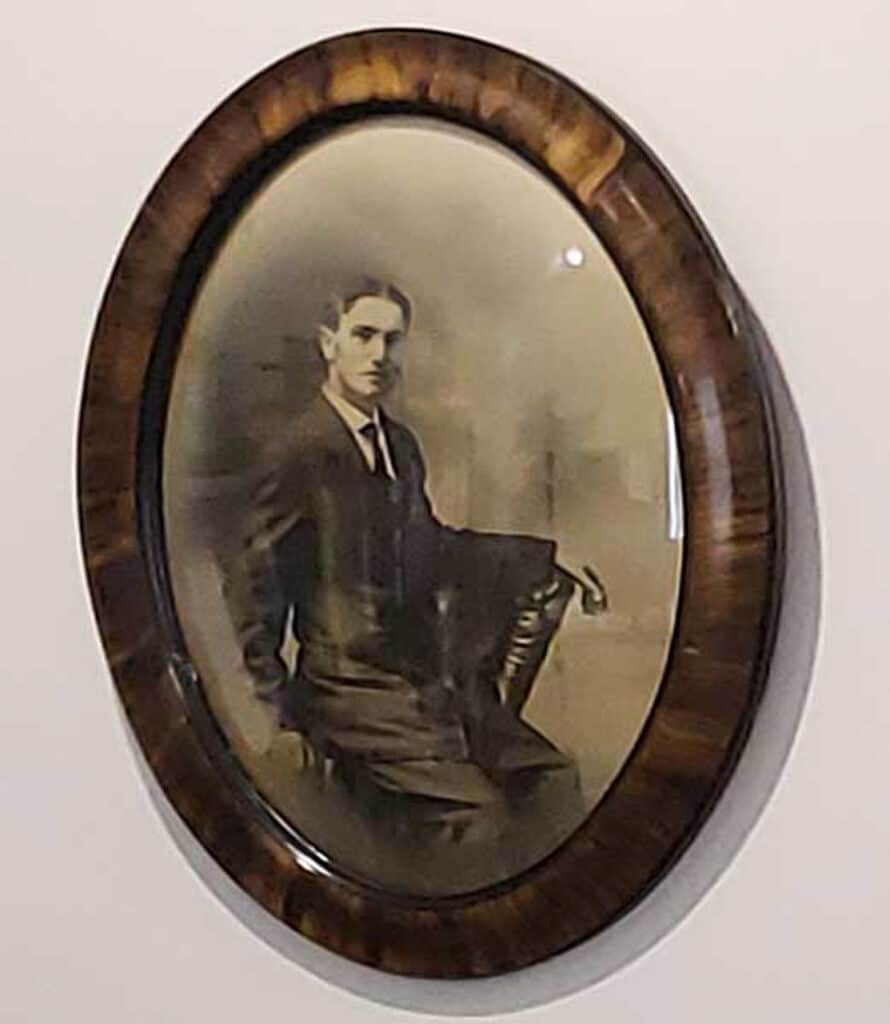
After writing at least a dozen successful novels set in Mexico, author Carmen Amato has returned to her roots with the Galliano Club Thrillers. The four-book series is set in the 1920s in the fictional city of Lido, NY, a setting inspired by the author’s Central New York hometown of Rome, NY.
Galliano Club readers follow the lives of three main characters throughout the novels, whose plots revolve around the themes of murder, blackmail, and revenge.
The prequel, Road to the Galliano Club, tells the story of the three characters and how their lives led them to Lido. Luca Lombardo immigrated as a young man from Calabria, Italy, carrying sorrow and a dark secret with him. Dancer Ruth Cross discovered Lido while on the Vaudeville circuit, and Benny Rotolo is a bootlegger who arrived from Al Capone’s violent, mobster-ruled Chicago.
Each subsequent novel—Murder at the Galliano Club, Blackmail at the Galliano Club, and Revenge at the Galliano Club—follows their lives and introduces a colorful cast of supporting characters.
The main action takes place in the year 1926. Prohibition is in full swing and Lido is comprised of neighborhoods made up of Italian, Polish, and Irish immigrants. Luca works at the Galliano Club in East Lido, where the city’s Italian men come to play pinochle, gossip, and read newspapers from the old country. Lido Premium Copper & Brass Rolling Mill is the major employer. The fictional mill mirrors Revere Copper, which has employed legions of real-life Romans throughout the years.

Part of the pleasure of reading the Galliano Club novels is in the granular details Amato writes with. Some of those details come from her lived experiences. Others are from a ledger that was kept by her grandfather, who was a deputy sheriff of Oneida County during Prohibition.
While Amato writes with her Upstate New York roots in mind, she also draws deeply from her 30-year career in the CIA. She describes the Galliano Club Thrillers as “The Godfather meets Cheers, with a dose of Boardwalk Empire.” Book 1 in the series, Murder at the Galliano Club won the Silver Falchion award for Best Historical Fiction of 2022.
I asked the author a few questions about her research, her roots, and some of the fabulous Italian food that shows up in the Galliano Club Thrillers.
Q: After a long international career, how did you reconnect to your roots in Upstate New York to write the Galliano Club series?
Every time I drive somewhere with undulating hills and lots of green space, I always think it looks like upstate New York. Perhaps I’ve never lost the connection to my roots.
I grew up in Rome in an Italian-American Catholic family. We lived next door to my grandparents and the highlight of the week was coffee and doughnuts in their kitchen after Sunday Mass. Every holiday meal with all the cousins was a feast, especially Christmas Eve with homemade linguini. On the Fourth of July, when everyone else was chowing down on hamburgers and hot dogs, we had rigatoni pasta stuffed with tiny meatballs.
I grew up, went to college, got a job, acquired a husband and two kids and spent years in Mexico and Central America where I discovered the same traditions of family, food, and faith. As a result, I felt right at home thanks to my roots in upstate New York.
My entire extended family, including my mother and three siblings, still live in upstate New York so a visit is always right around the corner.

Q: Can you talk about some of the ways you did research for the novels?
Welcome to 1926!
Calvin Coolidge is president, Al Smith is the governor of New York, and upstate New York is a major player in the country’s industrial expansion. Rome, my hometown, produces 10% of all copper used in American manufacturing.
Polish, Italian, and Irish immigrants work in the mills. They socialize separately, with churches and men’s clubs serving as social hubs for each community.
This was the history I wanted to recreate with the help of several regional landmarks.
The Stanley Theatre in Utica provided a private behind-the-scenes tour which sparked the character of Ruth Cross and her dance school above the Galliano Club. The theater is a stunning example of 1920’s architecture and has even retained the original pulley from vaudeville days to change scenery. The stairway in the lobby is an exact replica of the stairs on the Titanic.
The West End Brewery in Utica: I had to know how beer is made if I wanted to write about bootleggers! Now owned by Saranac, the West End brewery was the first brewery in the country to ship beer after Prohibition was repealed. It stayed afloat during Prohibition by making malt syrup and non-alcoholic beverages. I toured the entire place, including malt rooms, the bottling lines, and the old speakeasy.
The Saratoga Automobile Museum: My daughter and I made a pilgrimage to see a Franklin that belonged to Charles Lindbergh. Elegant touring cars, Franklins boasted air-cooled engines. The huge Franklin factory in Syracuse closed during the Depression.
Rome’s historic cemetery on Jervis Ave: Hundreds of elegantly carved tombstones punctuate this large, beautifully landscaped cemetery. Francis Bellamy, writer of the Pledge of Allegiance is buried there. The Gothic chapel-like mausoleums appear in Blackmail at the Galliano Club.
In addition, I combed through the holdings of the Oneida County Historical Society in Utica. Jervis Library and the Historical Society in Rome were also vital resources. eBay served up vintage books, maps, photographs and postcards.

Q: I know some of the Galliano Club plots were inspired by your grandfather’s career as deputy sheriff of Oneida County during Prohibition. Were any of the characters, like Benny Rotolo, the Chicago mobster with connections to Al Capone, based on real people?
As a matter of fact, scheming bootlegger Benny Rotolo was based on real-life gangster Earl “Hymie” Weiss. Born Henryk Wojciechowski, Weiss was one of the first members of Dean O’Banion’s North Side gang, rivals to Al Capone’s Chicago Outfit.
After O’Banion was murdered, Weiss took over the gang. Throughout 1926, he and Capone took potshots at each other. Finally in October, Capone’s wily lieutenant Frank Nitti arranged a hit, killing Weiss and several others and peppering Chicago’s Holy Name Cathedral with bullet holes in the process.
Rumor had it that Weiss was the only man Capone really feared. Weiss was brainy, but wildly violent and unpredictable. The term “take for a ride” or “one-way ride” is attributed to him. That tidbit turned into a scene in which a gangster named Tricker Egan meets an untimely end.
In the books Weiss is Benny Rotolo’s mentor. When Benny is forced to flee Chicago, he wants to build a bootlegging empire to reunite with Weiss and together take down Capone. It’s not as easy as Benny thinks, especially when the plan includes getting his hands on the Galliano Club.
Q: Do you have a favorite character in the series?
It’s hard to pick a favorite but Luca Lombardo is the only character whose photograph hangs in my office.
It’s a vintage sepia studio pose of a handsome young man wearing a suit several sizes too big. The moment I saw the oval frame in an antique store, I knew it was Luca as a newly arrived immigrant, fresh from Ellis Island and wearing borrowed clothes.
The photograph inspired Luca’s riveting backstory, which is told in the prequel, Road to the Galliano Club. It was a lucky find that helped turn a one-dimensional character into a flesh and blood person with hopes and dreams, triumphs and tragedies.

Q: Luca often seems to be whipping up one mouthwatering sandwich after another, with ingredients like prosciutto, provolone, and spicy soppressata salami, always made with crusty bread. Desserts like cannoli and pasticciotti also make appearances. How much was the fictional food inspired by your real-life experience in Rome?
Food is essential to the Galliano Club books because good food is essential to Italian life! Every sandwich, helping of lasagna or milanesa in the books came from personal experience, either in the US or Italy.
It made sense for sandwiches to be the signature Galliano Club dish. Hearty fare for the club’s blue-collar membership. Plus, dialogue could happen while Luca was slicing, spreading, and stacking.
You can find directions for making Luca’s mouth-watering sandwiches here.
Q: Can you recommend local cafes or restaurants for readers who wish to sample some of Central New York’s iconic Italian food?
Here are a few I’ve enjoyed:
Alteri’s in Clinton, down the road from Hamilton College, is a casual, family-friendly place. A classic Italian menu and yummy chicken marsala.
Grotto, in North Syracuse has wonderful food plus old world atmosphere featuring a pressed tin ceiling and white tablecloths. Delmonico’s Italian Steakhouse in Syracuse is a family favorite, with luscious desserts and the requisite photos of Frank Sinatra.
Grande’s Pizza in Rome looks like someplace to grab a slice to go but stay for the delicious greens—a regional specialty–and piping hot classic pizza. Another great spot in Rome is Copperccinos’s, an upscale coffee and sandwich spot next to the Capital Theatre. Their souvenir tees are worth the trip.
Finally, I’m in love with Joseph Putrello Coffee in Utica. Not far from the Stanley Theatre, it’s an unexpectedly elegant spot. Sit upstairs by one of the huge windows and let the world go by as you dunk a giant biscotti cookie into your latte.
Q: In the Foreword to the prequel, Road to the Galliano Club, you talk about the challenges Rome has faced over the years, and how much it has changed. Is there anything about Rome now that still reminds you of the city where you grew up?
Although much has changed, happily many of Rome’s historic residential neighborhoods endure, including George Street and Vogel Park, which became West Park Circle in the Galliano Club books.
Lake Delta is still a fun beach/picnic destination. Huge red brick factory buildings still dominate the cityscape although most are empty. Church steeples still soar above the downtown skyline and Italian businesses can still be found along Dominick Street, although not as many as in the city’s heyday.
The biggest changes have been to the city center. When I was in high school, Rome’s downtown was razed to build a replica of Fort Stanwix. Streets were closed to make a giant no car zone as if urban planners forgot it snows there six months out of the year. A strange carpeted (!) pedestrian overpass was a crime scene waiting to happen. Businesses died.
Today, the downtown area has been revamped, the creepy overpass is gone and streets have reopened. There’s even street parking! Anchored by the Capital Theatre, new shops and restaurants are springing up. Further east, in a nod to the city’s heritage, colorful street signs mark the historic Italian district.
Va bene!
It was a pleasure speaking with you, being featured on your beautiful site, and introducing your readers to the Galliano Club series. Thank you so much! All the best, Carmen
Thank you, too! This was so much fun to work on. I also grew up in Rome so I loved reading about the fictional versions of places I’m so familiar with.
Looks interesting! I’m going to recommend these to the book club I attend.
I always love talking to book clubs and would be delighted to connect with yours. All the best, Carmen
This would make a great read for a book club! There are so many detailed characters and fun plot twists, so there’s a lot to discuss.
Great interview with one of my favorite writers. The Galliano Club series is a winner — crackling action, interesting characters and a sense of place so strong it is a character unto itself.
Thank you for reading the interview. I totally agree with you about the strong sense of place. Once I finished the series, I regretted having to leave the world of Lido behind!
This book looks so interesting! I’ve already purchased it and am looking forward to reading it.
I love that there are four books to get immersed in. You don’t have to say goodbye to the characters after just one book. Happy reading!
Wow, this series sounds awesome! Would definitely be interested in diving in more. I love how there’s so much real life inspiration behind the storylines.
I love the real-life inspiration behind it, too! It adds a lot of reality to the fictional world.
I’m really looking forward to cozying up and transporting myself into this series. New York, prohibition, 1920’s, Italians, crime… what’s not to love???? Let the experience begin!
Happy reading!